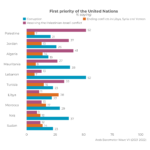In “Why Democracy Protests Do Not Diffuse,” we examine whether or not countries are significantly more likely to experience democracy protests when one or more of their neighbors recently experienced a similar protest. Our goal in so doing was not to attack the existing literature or to present sensational results, but to evaluate the extent to which the existing literature can explain the onset of democracy protests more generally. In addition to numerous studies attributing to diffusion the proliferation of democracy protests in four prominent waves of contention in Europe (1848, 1989, and early 2000s) and in the Middle East and North Africa (2011), there are multiple academic studies, as well as countless articles in the popular press, claiming that democracy protests have diffused outside these well-known regions and periods of contention (e.g., Bratton and van de Walle 1992; Weyland 2009; della Porta 2017). There are also a handful of cross-national statistical analyses that hypothesize that anti-regime contention, which includes but is not limited to democracy protests, diffuses globally (Braithwaite, Braithwaite, and Kucik 2015; Gleditsch and Rivera 2017; Escribà-Folch, Meseguer, and Wright 2018).1 Herein, we discuss what we can and cannot conclude from our analysis about the diffusion of democracy protests and join our fellow forum participants in identifying potential areas for future research. Far from closing this debate, we hope our article will stimulate further conversations and analyses about the theoretical and empirical bases of contention, diffusion, and democratization.
View External SiteTopics
- Charity2
- Corruption114
- COVID-1969
- Democracy36
- Discrimination14
- Economy227
- Education52
- Environment37
- Extremism19
- Freedoms51
- Gender Issues160
- Governance254
- Health45
- International Relations195
- Labor Market36
- Media31
- Migration64
- Political Institutions214
- Political Participation34
- Political Systems61
- Refugees6
- Religion118
- Security33
- Social Justice44
- Wellbeing2
- Youth75


